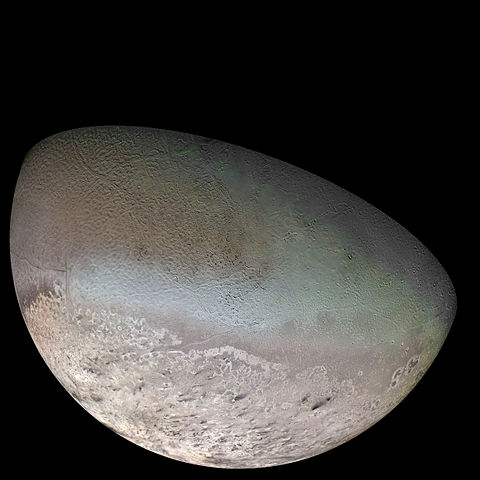 |
This is a file from the Wikimedia Commons. Information from its description page there is shown below.
Commons is a freely licensed media file repository. You can help.
|
| Description |
English: Global Colour Mosaic of Triton, taken by Voyager 2 in 1989
Deutsch: Globales Farbmosaik von Triton, 1989 aufgenommen durch Voyager 2
|
| Date |
25 August 1989 |
| Source |
http://photojournal.jpl.nasa.gov/catalog/PIA00317 |
| Author |
NASA / Jet Propulsion Lab / U.S. Geological Survey |
English: original NASA caption: Global color mosaic of Triton, taken in 1989 by Voyager 2 during its flyby of the Neptune system. Color was synthesized by combining high-resolution images taken through orange, violet, and ultraviolet filters; these images were displayed as red, green, and blue images and combined to create this colour version. With a radius of 1,350 km (839 mi), about 22% smaller than Earth's moon, Triton is by far the largest satellite of Neptune. It is one of only three objects in the Solar System known to have a nitrogen-dominated atmosphere (the others are Earth and Saturn's giant moon, Titan). Triton has the coldest surface known anywhere in the Solar System (38 K, about -391 degrees Fahrenheit); it is so cold that most of Triton's nitrogen is condensed as frost, making it the only satellite in the Solar System known to have a surface made mainly of nitrogen ice. The pinkish deposits constitute a vast south polar cap believed to contain methane ice, which would have reacted under sunlight to form pink or red compounds. The dark streaks overlying these pink ices are believed to be an icy and perhaps carbonaceous dust deposited from huge geyser-like plumes, some of which were found to be active during the Voyager 2 flyby. The bluish-green band visible in this image extends all the way around Triton near the equator; it may consist of relatively fresh nitrogen frost deposits. The greenish areas includes what is called the cantaloupe terrain, whose origin is unknown, and a set of "cryovolcanic" landscapes apparently produced by icy-cold liquids (now frozen) erupted from Triton's interior.
Deutsch: Ursprüngliche Überschrift der NASA: Global colour mosaic of Triton, wurde 1989 während des Fly-by bei Neptun abgelichtet. Die Farbe wurde durch Kombinieren von hochaufgelösten Bildern, die durch orange, rote, violette und ultraviolette Filter aufgenommen wurde, zusammengesetzt. Diese Bilder wurden in roten, grünen und blauen Bilder angezeigt und dann zusammengefasst, um ein Farbbild zu generieren. Mit einem Radius von 1350 km, etwa 22 % kleiner als der Erdmonde, ist Triton der mit Abstand größte Mond des Neptuns. Er ist einer von drei Objekten im Sonnensystem, der eine Stickstoff dominierte Atmosphäre aufweist (die anderen zwei sind die Erde und der große Saturnmond Titan). Triton hat mit 38 K (-235 °C) die kälteste Oberfläche im ganzen Sonnensystem vorzuweisen. Es ist so kalt, dass der Großteil von Tritons Stickstoff als Frost kondensiert ist. Das macht ihm zum einzigen Satelliten im Sonnensystem, der eine Oberfläche hauptsächlich aus Stickstoffeis besitzt. Die rosafarbenen Ablagerungen bilden eine massive Südpolkappe. Es wird geglaubt, sie bestehe aus Methaneis, das unter Sonnenlicht reagiert hat, und bilden so die roten oder rosa Verbindungen. Die dunklen Streifen, die die roten Eise überlagern, könnten eisiger und vielleicht kohlehaltiger Staub sein, die von riesigen geysirartigen Rauchfahnen abgelagert wurden. Von diesen Geysiren wurden einige aktive durch Voyager 2 beobachtet. Das blaugrüne Band, das im Bild sichtbar ist, erstreckt sich den ganzen Weg entlang des Äquators. Es könnte aus relativ frisch gefrorenen Stickstoffablagerungen bestehen. Die grünlichen Gebiete beinhalten sogenanntes „Melonenterrain“, dessen Ursprung unbekannt ist und eine Zusammenstellung aus "kryovulkanischen" (eisvulkanischen) Landschaften, die anscheinend von eisig kalten, nun gefrorenen Flüssigkeiten stammen könnten, die von Tritons Innerem ausgebrochen sind.
Licensing
| Public domainPublic domainfalsefalse |
 |
This file is in the public domain because it was solely created by NASA. NASA copyright policy states that "NASA material is not protected by copyright unless noted". (See Template:PD-USGov, NASA copyright policy page or JPL Image Use Policy.) |
|
|
|
Warnings:
- Use of NASA logos, insignia and emblems are restricted per US law 14 CFR 1221.
- The NASA website hosts a large number of images from the Soviet/ Russian space agency, and other non-American space agencies. These are not necessarily in the public domain.
- Materials based on Hubble Space Telescope data may be copyrighted if they are not explicitly produced by the STScI. See also {{ PD-Hubble}} and {{ Cc-Hubble}}.
- The SOHO (ESA & NASA) joint project implies that all materials created by its probe are copyrighted and require permission for commercial non-educational use.
- Images featured on the Astronomy Picture of the Day (APOD) web site may be copyrighted.
|
File usage
The following pages on Schools Wikipedia link to this image (list may be incomplete):
This file contains additional information, probably added from the digital camera or scanner used to create or digitize it. If the file has been modified from its original state, some details may not fully reflect the modified file.





